Software:Valknut
 Valknut in KDE | |
| Developer(s) | Mathias Küster, Edward Sheldrake |
|---|---|
| Stable release | 0.3.23 (Qt3), 0.4.9 (Qt4)
/ 10 February 2009 |
| Written in | C++ |
| Operating system | Linux, FreeBSD, Mac OS X, Microsoft Windows, OS/2 resp. eComStation |
| Type | Peer-to-peer (P2P) |
| License | GPL |
| Website | wxdcgui |
Valknut is a client program for peer-to-peer file sharing that uses the Direct Connect protocol. It is compatible with other DC clients, such as the original DC from Neomodus, DC++ and derivatives. Valknut also interoperates with all common DC hub software.
Valknut was originally written by Mathias Küster and is licensed under the terms of the GNU General Public License (GPL). It is written in C++ and uses the cross-platform Qt library for its GUI. Valknut compiles and runs on Linux, FreeBSD, Mac OS X, Microsoft Windows, and OS/2 - eComStation.
Originally, Valknut was called DCGUI, which was similar to the name of another Linux DC client. It was then renamed to dcgui-qt to avoid confusion. However, trademark problems relating to the use of 'Qt' in the name forced another name change, to Valknut.
Following the release of Valknut 0.3.7, Mathias Küster stopped working on Valknut. Edward Sheldrake then moved (forked?) the code into the wxDCGUI project, where work is underway [when?] to add additional features, as well as to port Valknut's Qt3 user interface to Qt4 and eventually to wxWidgets. In May 2008 the first Qt4 version was released.[citation needed]
During startup, the graphics of the splash screen show a Valknut.
EiskaltDC is a disconnected fork of Valknut.
EiskaltDC++ is a fork of DC++ (only kernel, without GUI) but programmed by the same authors. Packages with EiskaltDC++ have been available for example on Fedora, OpenSUSE[1] or Debian.[2]
There are various graphical interfaces available, using GTK+ version 2 and 3 and Qt version 4 and 5 for the GUI widgets. There also is daemon that is remote controllable via JSON-RPC by CLI on Perl and WebUI on JavaScript.[3]
References
External links
- Valknut on SourceForge.net
- Mac OS X binary releases
- EiskaltDC on SourceForge.net - (fork Valknut)
- EiskaltDC++ on SourceForge.net - EiskaltDC++ (completely new client from EiskaltDC developers)

